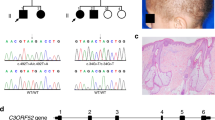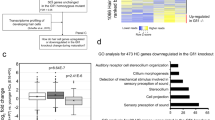Abstract
Marie Unna hereditary hypotrichosis (MUHH) is an autosomal dominant form of genetic hair loss. In a large Chinese family carrying MUHH, we identified a pathogenic initiation codon mutation in U2HR, an inhibitory upstream ORF in the 5′ UTR of the gene encoding the human hairless homolog (HR). U2HR is predicted to encode a 34–amino acid peptide that is highly conserved among mammals. In 18 more families from different ancestral groups, we identified a range of defects in U2HR, including loss of initiation, delayed termination codon and nonsense and missense mutations. Functional analysis showed that these classes of mutations all resulted in increased translation of the main HR physiological ORF. Our results establish the link between MUHH and U2HR, show that fine-tuning of HR protein levels is important in control of hair growth, and identify a potential mechanism for preventing hair loss or promoting hair removal.
This is a preview of subscription content, access via your institution
Access options
Subscribe to this journal
Receive 12 print issues and online access
$209.00 per year
only $17.42 per issue
Buy this article
- Purchase on Springer Link
- Instant access to full article PDF
Prices may be subject to local taxes which are calculated during checkout




Similar content being viewed by others
Change history
28 April 2009
NOTE: The affiliation of the 24th author, Alessandro Terrinoni, was listed incorrectly. It should read IDI-IRCCS Biochemistry Laboratory c/o Univ. Tor Vergata, 00133 Rome, Italy. The error has been corrected in the HTML and PDF versions of this article.
References
Paus, R. & Cotsarelis, G. The biology of hair follicles. N. Engl. J. Med. 341, 491–497 (1999).
Stenn, K.S. & Paus, R. Controls of hair follicle cycling. Physiol. Rev. 81, 449–494 (2001).
Cotsarelis, G. Epithelial stem cells: a folliculocentric view. J. Invest. Dermatol. 126, 1459–1468 (2006).
Alonso, L. & Fuchs, E. Stem cells in the skin: waste not, Wnt not. Genes Dev. 17, 1189–1200 (2003).
Huelsken, J., Vogel, R., Erdmann, B., Cotsarelis, G. & Birchmeier, W. beta-Catenin controls hair follicle morphogenesis and stem cell differentiation in the skin. Cell 105, 533–545 (2001).
Andl, T., Reddy, S.T., Gaddapara, T. & Millar, S.E. WNT signals are required for the initiation of hair follicle development. Dev. Cell 2, 643–653 (2002).
Van Mater, D., Kolligs, F.T., Dlugosz, A.A. & Fearon, E.R. Transient activation of beta-catenin signaling in cutaneous keratinocytes is sufficient to trigger the active growth phase of the hair cycle in mice. Genes Dev. 17, 1219–1224 (2003).
Ito, M. et al. Wnt-dependent de novo hair follicle regeneration in adult mouse skin after wounding. Nature 447, 316–320 (2007).
Potter, G.B. et al. The hairless gene mutated in congenital hair loss disorders encodes a novel nuclear receptor corepressor. Genes Dev. 15, 2687–2701 (2001).
Beaudoin, G.M. III, Sisk, J.M., Coulombe, P.A. & Thompson, C.C. Hairless triggers reactivation of hair growth by promoting Wnt signaling. Proc. Natl. Acad. Sci. USA 102, 14653–14658 (2005).
Thompson, C.C., Sisk, J.M. & Beaudoin, G.M. III. Hairless and Wnt signaling: allies in epithelial stem cell differentiation. Cell Cycle 5, 1913–1917 (2006).
Ahmad, W. et al. Alopecia universalis associated with a mutation in the human hairless gene. Science 279, 720–724 (1998).
Cichon, S. et al. Cloning, genomic organization, alternative transcripts and mutational analysis of the gene responsible for autosomal recessive universal congenital alopecia. Hum. Mol. Genet. 7, 1671–1679 (1998).
Sprecher, E., Bergman, R., Szargel, R., Friedman-Birnbaum, R. & Cohen, N. Identification of a genetic defect in the hairless gene in atrichia with papular lesions: evidence for phenotypic heterogeneity among inherited atrichias. Am. J. Hum. Genet. 64, 1323–1329 (1999).
Unna, M. Über hypotrichosis congenita hereditaria. Dermatol. Wochenschr. 81, 1167–1178 (1925).
van Steensel, M. et al. The gene for hypotrichosis of Marie Unna maps between D8S258 and D8S298: exclusion of the hr gene by cDNA and genomic sequencing. Am. J. Hum. Genet. 65, 413–419 (1999).
Sreekumar, G.P., Roberts, J.L., Wong, C.Q., Stenn, K.S. & Parimoo, S. Marie Unna hereditary hypotrichosis gene maps to human chromosome 8p21 near hairless. J. Invest. Dermatol. 114, 595–597 (2000).
Lefevre, P. et al. Linkage of Marie-Unna hypotrichosis locus to chromosome 8p21 and exclusion of 10 genes including the hairless gene by mutation analysis. Eur. J. Hum. Genet. 8, 273–279 (2000).
Cichon, S. et al. A distinct gene close to the hairless locus on chromosome 8p underlies hereditary Marie Unna type hypotrichosis in a German family. Br. J. Dermatol. 143, 811–814 (2000).
He, P.P. et al. Refinement of a locus for Marie Unna hereditary hypotrichosis to a 1.1-cM interval at 8p21.3. Br. J. Dermatol. 150, 837–842 (2004).
Scheper, G.C., van der Knaap, M.S. & Proud, C.G. Translation matters: protein synthesis defects in inherited disease. Nat. Rev. Genet. 8, 711–723 (2007).
Cazzola, M. & Skoda, R.C. Translational pathophysiology: a novel molecular mechanism of human disease. Blood 95, 3280–3288 (2000).
Wiestner, A., Schlemper, R.J., van der Maas, A.P. & Skoda, R.C. An activating splice donor mutation in the thrombopoietin gene causes hereditary thrombocythaemia. Nat. Genet. 18, 49–52 (1998).
Liu, L. et al. Mutation of the CDKN2A 5′ UTR creates an aberrant initiation codon and predisposes to melanoma. Nat. Genet. 21, 128–132 (1999).
Panteleyev, A.A., Paus, R. & Christiano, A.M. Patterns of hairless (hr) gene expression in mouse hair follicle morphogenesis and cycling. Am. J. Pathol. 157, 1071–1079 (2000).
Yang, S. et al. Identification of a novel locus for Marie Unna hereditary hypotrichosis to a 17.5 cM interval at 1p21.1–1q21.3. J. Invest. Dermatol. 125, 711–714 (2005).
Iacono, M., Mignone, F. & Pesole, G. uAUG and uORFs in human and rodent 5′untranslated mRNAs. Gene 349, 97–105 (2005).
Churbanov, A., Rogozin, I.B., Babenko, V.N., Ali, H. & Koonin, E.V. Evolutionary conservation suggests a regulatory function of AUG triplets in 5′-UTRs of eukaryotic genes. Nucleic Acids Res. 33, 5512–5520 (2005).
Sachs, M.S. & Geballe, A.P. Downstream control of upstream open reading frames. Genes Dev. 20, 915–921 (2006).
Niiyama, S., Freyschmidt-Paul, P., Happle, R. & Hoffmann, R. Hypotrichosis of congenital of Marie Unna. Eur. J. Dermatol. 11, 379–380 (2001).
Acknowledgements
We thank the family members for their participation in the study, and J. Zeller, S. Burge and M. Young for referring patients. This work was supported mainly by the National Natural Science Foundation of China (funds 30730097 and 30721063 to X.Z.). X.Z. is a Chang Jiang Scholar of Genetic Medicine supported by the Ministry of Education, China. C.-D.H. was supported by the National Natural Science Foundation of China (30771948). The McLean laboratory is supported by grants from the Dystrophic Epidermolysis Bullosa Research Association, the Pachyonychia Congenita Project, the British Skin Foundation, the National Eczema Society and the Medical Research Council (G0700314). S.Y. is supported by the Ministry of Education, China (SRFDP 20050366004). The German group is supported by grants from the Deutsche Forschungsgemeinschaft (Research Unit FOR 423 to M.M.N. and R.K. and Emmy Noether Programme to R.C.B.). M.M.N. holds an Alfried Krupp von Bohlen and Halbach-Chair in Genetic Medicine. R.S. and J.G. are supported by Epiderm, the Scientific Research Fund of the Australasian College of Dermatologists and the Scientific Research Fund of the Skin and Cancer Foundation of Victoria.
Author information
Authors and Affiliations
Contributions
X.Z. designed and oversaw the entire project. X.Z. and C.-D.H. initiated the study. X.Z. and W.H.I.M. coordinated the mutation screening work and prepared the manuscript. Y.W., Y. Liu, Y.Z. and M.v.G. carried out the linkage analysis and mutation screening. Y.X., R.H., K.W. and Y.W. conducted the mRNA and protein expression experiments. X.Z. and Y.W. conducted the bioinformatics analysis. M.S., D.S., Q.L., Y. Luo and L.J. supported the genetic analyses. H.-D.C. and W.H.-Y.L. supported the study design. Y. Liu, S.Y., X.-J.Z., R.K., S.C., R.C.B., M.M.N., M.A.M.v.S., P.M.S., D.H., M.H., G.S.D., C.K., A.M., C.S.M., A.T., A.H., C.B., Y.d.P., A.S.P., A.D.I., R.S. and J.G. were responsible for clinical evaluation and sample collection, including earlier published linkage studies.
Corresponding authors
Ethics declarations
Competing interests
X.Z., C.-D.H., Y.W., Y. Liu, Y.X., R.H., K.W. and M.S. have applied for a patent relating to the U2HR sequence.
Supplementary information
Supplementary Text and Figures
Supplementary Figures 1–4 and Supplementary Table 1 (PDF 297 kb)
Rights and permissions
About this article
Cite this article
Wen, Y., Liu, Y., Xu, Y. et al. Loss-of-function mutations of an inhibitory upstream ORF in the human hairless transcript cause Marie Unna hereditary hypotrichosis. Nat Genet 41, 228–233 (2009). https://doi.org/10.1038/ng.276
Received:
Accepted:
Published:
Issue Date:
DOI: https://doi.org/10.1038/ng.276
This article is cited by
-
The stem cell quiescence and niche signaling is disturbed in the hair follicle of the hairpoor mouse, an MUHH model mouse
Stem Cell Research & Therapy (2022)
-
Alopezien und Hypotrichosen im Kindesalter: Wann muss an genetische Diagnostik gedacht werden?
Monatsschrift Kinderheilkunde (2021)
-
Translational Inhibition of α-Neurexin 2
Scientific Reports (2020)
-
Characterising the loss-of-function impact of 5’ untranslated region variants in 15,708 individuals
Nature Communications (2020)
-
Retinoid acid induced 16 deficiency aggravates colitis and colitis-associated tumorigenesis in mice
Cell Death & Disease (2019)



